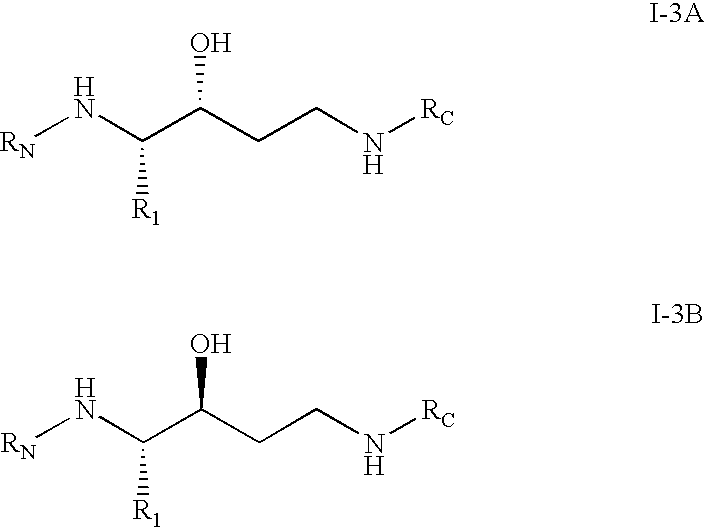Hydroxypropylamines
a technology of hydroxypropylamine and hydroxypropylamine, which is applied in the field of compounds useful in the treatment of alzheimer's disease, can solve the problems of no effective treatment for halting, preventing, or reversing the progression of alzheimer's disease, and achieving the effects of inhibiting the production of a-beta peptides, preventing the potential consequences of alzheimer's disease, and inhibiting beta-secr
- Summary
- Abstract
- Description
- Claims
- Application Information
AI Technical Summary
Benefits of technology
Problems solved by technology
Method used
Image
Examples
chemistry examples
Example 1
Synthesis of 5-amino-1,2,4,5-tetradeoxy-1-(3,5-difluorophenyl)-2-({3-[(dipropylamino)carbonyl]-5-methylbenzoyl}amino)-L-threo-pentitol (69)
[0431]Treatment of epoxide 65 with potassium cyanide followed by the removal of the Boc group afforded amine 66 (Scheme below). Coupling of acid 67 and amine 66 in the presence of HBTU provided 68, which was hydrogenated to provide ALB 9218 (69). This compound was shipped to Pharmacia Corporation on Jan. 22, 2002.
[0432]
[0433]Step 1: To a stirred solution of epoxide 65 (2.01 g, 6.7 mmol) in N,N-dimethylformamide (20 mL) was added potassium cyanide (660 mg, 10.0 mmol) and water (2 mL). The reaction mixture was stirred at room temperature for 20 h and then quenched with 1 N KH2PO4 (20 mL). The mixture was extracted with ethyl acetate (3×50 mL). The combined extracts were washed with saturated sodium chloride, dried (sodium sulfate), filtered, and concentrated under reduced pressure. Purification by flash column chromatography (silica gel, 3...
example a
[0439]The compounds of the invention are analyzed for inhibitory activity by use of the MBP-C125 assay. This assay determines the relative inhibition of beta-secretase cleavage of a model APP substrate, MBP-C125SW, by the compounds assayed as compared with an untreated control. A detailed description of the assay parameters can be found, for example, in U.S. Pat. No. 5,942,400. Briefly, the substrate is a fusion peptide formed of maltose binding protein (MBP) and the carboxy terminal 125 amino acids of APP-SW, the Swedish mutation. The beta-secretase enzyme is derived from human brain tissue as described in Sinha et al, 1999, Nature 40:537–540) or recombinantly produced as the full-length enzyme (amino acids 1–501), and can be prepared, for example, from 293 cells expressing the recombinant cDNA, as described in WO00 / 47618.
[0440]Inhibition of the enzyme is analyzed, for example, by immunoassay of the enzyme's cleavage products. One exemplary ELISA uses an anti...
example b
[0445]Cell Free Inhibition Assay Utilizing a Synthetic APP Substrate
[0446]A synthetic APP substrate that can be cleaved by beta-secretase and having N-terminal biotin and made fluorescent by the covalent attachment of Oregon green at the Cys residue is used to assay beta-secretase activity in the presence or absence of the inhibitory compounds of the invention. Useful substrates include the following:
[0447]
[SEQ ID NO:1]Biotin-SEVNL-DAEFRC[oregon green]KK[SEQ ID NO:2]Biotin-SEVKM-DAEFRC[oregon green]KK[SEQ ID NO:3]Biotin-GLNIKTEEISEISY-EVEFRC[oregon green]KK[SEQ ID NO:4]Biotin-ADRGLTTRPGSGLTNIKTEEISEVNL-DAEFRC[oregon green]KK[SEQ ID NO:5]Biotin-FVNQHLCoxGSHLVEALY-LVCoxGERGFFYTPKAC[oregon green]KK
[0448]The enzyme (0.1 nanomolar) and test compounds (0.001–100 micromolar) are incubated in pre-blocked, low affinity, black plates (384 well) at 37 degrees for 30 minutes. The reaction is initiated by addition of 150 millimolar substrate to a final volume of 30 microliter per well. The final...
PUM
| Property | Measurement | Unit |
|---|---|---|
| Composition | aaaaa | aaaaa |
Abstract
Description
Claims
Application Information
 Login to View More
Login to View More - R&D
- Intellectual Property
- Life Sciences
- Materials
- Tech Scout
- Unparalleled Data Quality
- Higher Quality Content
- 60% Fewer Hallucinations
Browse by: Latest US Patents, China's latest patents, Technical Efficacy Thesaurus, Application Domain, Technology Topic, Popular Technical Reports.
© 2025 PatSnap. All rights reserved.Legal|Privacy policy|Modern Slavery Act Transparency Statement|Sitemap|About US| Contact US: help@patsnap.com



